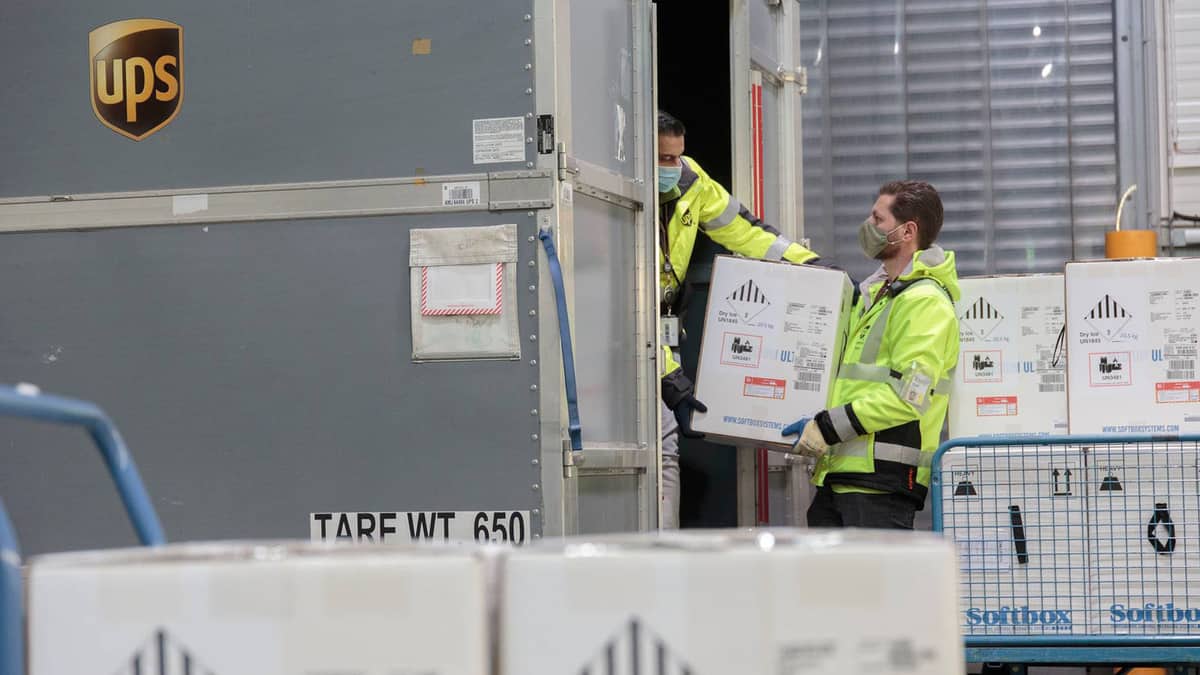FedEx and UPS are delivering COVID-19 vaccines to many more locations this week as the logistics campaign behind the nationwide immunization program continues to scale up and settle into a predictable rhythm.
And they may not stop for Christmas.
The recently approved Moderna (NASDQ: MRNA) vaccine is going to 3,400 locations on Monday and Tuesday, with an additional 1,000 administration sites receiving Pfizer Inc.’s (NYSE: PFE) vaccine, said U.S. Army General Gus Perna, who heads the Operation Warp Speed task force orchestrating the outbound supply chain, during a press briefing Monday.
The number of drop sites is more than the 3,285 previously mentioned for the Moderna shipments, and the total number of locations is much more than the 636 sites that received the Pfizer vaccine during the first half of last week. At least 1,300 long-term care facilities are on tap to receive the drugs after officials mostly targeted health care facilities and medical workers during week one.
Trucks began picking up the Moderna shipments on Sunday at distribution centers operated by health care specialist McKesson Corp. (NYSE: MCK). Warehouse workers packed insulated containers holding the vials and special cold packs into boxes and loaded them on FedEx Express (NYSE: FDX) and UPS (NYSE: UPS) vehicles.
Subcontractors, such as Boyle Transportation and XPO Logistics (NYSE: XPO) for UPS, are also helping transport the vaccines to airports and other transfer points. Perna said he isn’t involved with them, letting the prime contractors coordinate and hold their partners accountable.
The plan is to keep delivering through Thursday, but if states ask for shipments to meet a need, “industry is ready to go with delivery on Christmas Day to make sure everyone has access to the vaccine,” Perna said.
He praised the “Herculean effort” of the manufacturers, McKesson and the express carriers.
“This weekend when most of America tried to take a couple days off, these industry partners worked to make sure vaccines were properly stored, packed, labeled and moved into distribution places so that we can deliver on a regular basis as orders occur,” Perna said.
Officials expressed confidence that they will have allocated 20 million doses to states by the end of the year, with deliveries completed during the first week of January.
Up to 50 million are likely to get their first vaccine dose by the end of January, with 100 million shots, including a follow-on booster, administered by March.
Operation Warp Speed’s goal is to establish a regular rhythm of deliveries, with increased quantities each week, Perna stressed.
The command center will notify states on Tuesdays of their individual allocations from the available stocks so they can prepare designated sites to receive and administer the vaccine. The orders are locked on Thursdays and late orders will get shipped after the first wave the following week.
Quality controls protect cold chain
Perna stressed that open communication between all industry partners and the government was critical to ironing out any kinks and making accurate, on-time deliveries.
“We want to make sure from the strategic, to the operational, to the tactical level everybody is synched and nested, and that we get stronger on that every day,” Perna said.
“It’s been powerful to watch the collaboration between Pfizer, Moderna and McKesson, and UPS and FedEx,” he added. “It’s really spectacular to see the senior leaders of these organizations personally be involved in this effort. So what I have a lot of confidence in is the quality control that is being executed by these companies to ensure that the vaccine arrives safely and ready to administer.”
Those quality controls became apparent last week when four trays of the Pfizer vaccine drifted out of their optimal temperature range of minus 70 degrees Celsius.
As previously reported, when logisticians noticed temperature probes wirelessly sending readings of minus 92 degrees C, they immediately alerted the delivery-van drivers to return the shipments and sent replacement doses.
Perna said Monday and over the weekend that Pfizer analyzed the vaccines and determined the colder temperature had no effect on the product, but the decision to reroute was made as a precaution.
He theorized the temperature anomaly could have resulted from dry ice shifting in the box during transport and creating colder pockets in certain areas.
“The key to this is the diligence and the professionalism and the immediacy which Pfizer reacted in combination with FedEx and UPS. They have a remarkable ability to [view their networks]. Take control. Quarantine. Return and replace the vaccine. It was just spectacular. And I applaud everybody involved with that,” Perna said.
Click here for more FreightWaves/American Shipper stories by Eric Kulisch.
RELATED NEWS:
McKesson distribution centers ship first Moderna COVID-19 vaccines
FedEx, UPS mobilize to deliver Moderna COVID vaccine
XPO Logistics provides truck transport for Pfizer vaccine
More than 3,000 sites to receive Moderna COVID vaccine










